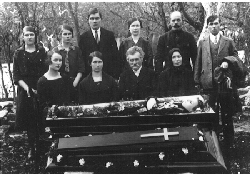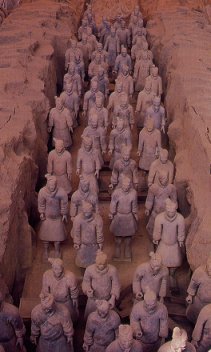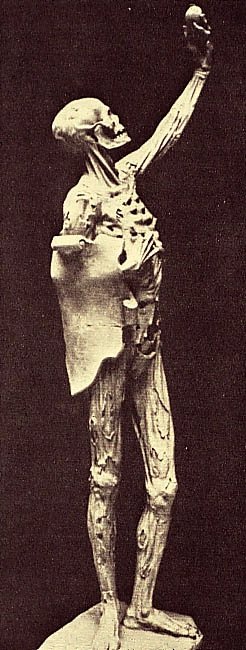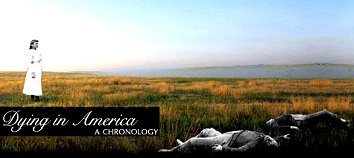IMAGES ACROSS
CULTURES AND
TIME
"At birth we cry; at death we see
why."
--Bulgarian proverb
"Birth is the messenger of
death."
--Syrian proverb

Like the climatologists who so eagerly awaited the
close-up photographs of Jupiter and Saturn in order to understand the atmospheric
dynamics of earth, we need cross-cultural comparisons in order to comprehend
ourselves. "Death" is a socially constructed idea. The fears,
hopes, and orientations people have towards it are not instinctive, but
rather are learned from such public symbols as the languages, arts,
and religious and funerary rituals of their culture. Every
culture has a coherent mortality thesis whose explanations of death are so thoroughly
ingrained that they are believed to be right by its members. It is here
assumed that any broad-scale change in the relationships between the living
is accompanied by modifications of these death meanings and ceremonies.
The reverse may well also be true: Would there be a rash of suicides if
it were to be conclusively verified scientifically that the hereafter is
some celestial Disneyland? And what if the quality of one's experiences
there was founded to be based on the quality of one's life?
- Annwfn: The Mythology and Folklore of Death from
The City of the Silent
- H.C. Yarrow's 1881 "Introduction to the Study of Mortuary Customs
Among the North American Indians"
- Myth in Death and Dying
- Euphemisms for Death
-- both physical and symbolic (with a dash of humor)

If you were to parachute down into some exotic culture,
precisely how would you classify its death
ethos (or death
system), the entire veil of order and meaning that societies construct
against the chaos posed by death?
Anthropology provides various strategies. Among the cultural indicators to be the
considered would be:
- nature of their beliefs toward the meaning of life,
death and the hereafter;
- funerary rituals and strategies
for body disposal;
- as illustrated in the image on the right, the physical and
symbolic boundaries between
the worlds of the living and the dead;
- the perceived role of the dead on the affairs of the
living;
- whether the dying process is a public or private event;
- the degree of social stigma attached to those dying,
dead, or bereaved;
- orientations toward and rates of suicide, murder (perhaps
broken into categories of infanticide, genocide, etc.), and abortion;
- centrality of social goal of death prevention and
avoidance;
- the death socialization of children (including death
themes in children's stories and games) and their involvement in funerary
ritual;
- the taboo status of the topic of dying and death in
everyday discourse;
- the language used regarding death (have you noticed
how often in American culture we employ euphemism to describe death and
yet how we use death metaphors to describe non-death-related matters (e.g.,
their team killed ours last night; if you don't work hard you will be terminated
or axed);
- and the nature and conceptions of death in the arts.
In considering the various facets of death ethos
cross-culturally,
Arnold Toynbee ("Various Ways in Which Human Beings Have Sought to
Reconcile Themselves to the Fact of Death," 1980) and others have
developed typologies of orientations toward life and death:

- Cultures can be death-accepting, death-denying or
even death- defying. In the death-defying West, the strategies for salvation
have historically included activism and asceticism. In the East, the strategies
have often been more contemplative and mystical.
- Death may be considered either as the end of existence
or as a transition to another state of being or consciousness. For Buddhists and Hindus, the
arch-ordeal envisioned is not death but rather the pain
of having to undergo another rebirth. It is the end of rebirths that is
their goal, not the end of death, which is the goal of Christianity.
- Considering the two previous dimensions, it should
be evident that death can be viewed as either sacred or profane, a state
or process perceived either to be sacrosanct or polluting for the living.
- Where there is some immortality conception, it can
either be personal or collective. In the West, post-death conceptions typically
involve the integrity and continuity of one's personal self. In the East,
the ultimate goal is often an undifferentiated and impersonal oneness with
the universe.
- Cultures have taken hedonistic and pessimistic orientations
toward life in facing the inevitability of death, such as taking an "eat,
drink, and be merry for tomorrow we may die" approach to life.
- The American notion of life being what's objective
and concrete while the hereafter has an illusory quality is far from being
universal. The Hindus, for example, handle the problem of death by viewing
life as the illusion and the realm between reincarnations as that which
is objective. Hence, for many in Eastern cultures the primary concern is
to avoid rebirth by extinguishing one's self-centeredness (thereby, for
the Buddhists, being absorbed into an impersonal, collective oversoul),
while in much of the West, this concern is to obtain as high a quality
of personal existence as is possible in the here-and-now.

Before getting too carried away with this classification
business, it's worth reflecting on the value of the enterprise. Say that
we have for each dimension of a cultural death system a set of mutually
exclusive and totally exhaustive categories such that each culture can
be pigeon-holed into one and only one, what then? So what?
 The first step might to see how these various categories
cluster together. For instance, are there patterns in the way beliefs in
an afterlife correlate with cultural/personal orientations toward abortion
or euthanasia? Is cultural thanatophia related to cultural gerontophobia--
in other words, do death fears lead to fears of growing old? This question
brings us to the second and most important step: how orientations toward
death relate to orientations toward life.
The first step might to see how these various categories
cluster together. For instance, are there patterns in the way beliefs in
an afterlife correlate with cultural/personal orientations toward abortion
or euthanasia? Is cultural thanatophia related to cultural gerontophobia--
in other words, do death fears lead to fears of growing old? This question
brings us to the second and most important step: how orientations toward
death relate to orientations toward life.
At issue is the relationship between a culture's death
ethos and its life ethos, the latter described by Clifford Geertz (The
Interpretation of Cultures: Selected Essays, 1973:127) as "the
tone, character, and quality of their life, its moral and aesthetic style
and mood; ... the underlying attitude toward themselves and their world
that life reflects." For instance, what facets of their death ethos
lead the Spanish to disdain the life insurance industry?
Public distaste for life insurance has left the industry in Spain
more malnourished than in any other major Western European economy. Only
nine of every 100 Spaniards have life insurance, for an estimated annual
per capita premium cost of $10.20. That compares to $154 in Western Europe
and $230 in the U.S....
Some examples of what insurance sales people must contend with in
Spain:
- The mother of a drowned fisherman flatly refused to accept his death
benefits from an insurance company.
- A village priest railed against the trade, asking, `Who but God
can insure life?'
- Last month, the Socialist General Union of Workers denounced Spain's
state-controlled telephone company for providing `scandalous' life insurance
and pension coverage for 160 top executives.
--Ana
Westley. 1984. "Spaniards Distaste for Life Insurance Leave the Industry There Languishing."
Wall Street Journal, March 29:28
"The fundamental law of the social order [is] ... the progressive
control of life and death."
-- Jean Baudrillard, Symbolic Exchange and Death, p.172
A major tradition in the study of death across cultures
and time has been to demarcate distinctive death epochs in Western history.
The most notable illustration is Philippe Ariès's The Hour of Our Death,
wherein developed are five models of death that have succeeded one another
of the past millennium:
- tame
death. Here death was considered a process that
was both familiar and near, featuring a simple public and ritualistic ceremony
largely controlled by the dying person and for which friends and family,
including the children, were present.

- death of self. With the
devastating
Black Plague,
increasing individualism, and the weakening of traditional community ties
(with perhaps a growing collective sense of the demise of the old feudal
order), dying became the time when the true essence of oneself was assumed
to be revealed. The macabre iconography
of this era (for more images see As
I am so thou shalt be) often featuring partially decomposed cadavers with maggots
and snakes, has been variously interpreted. Perhaps it was an era of a
renewed appreciation of life and its possibilities. Indeed, a life was
no longer subsumed within the collective destiny of the group (hence the
fading of the vendetta system, as kin members were no longer seen to be
functionally equivalent, but became viewed as a biography, each moment
of which would be judged by Christ after death. It was at this time that
people concerned themselves with their distinguishing characteristics,
began writing autobiographies, became interested in drama and in the
distinctions between roles and their occupants, and postulated the existence
of an internal inner self. To assist in individuals' mastery of their own
deaths, an instructional manual on the art of dying, entitled Ars
Moriendi, was to be a best seller for two centuries. Other resources: University of Chicago's "The Plague: Buboes,
Masses and Kinases; Patrick Pollefeys' "As
I am so thou shalt be;" and Tom Bacig's "The
Black Death" page.
- remote and imminent death. With
increasing secularization and the Enlightenment's rise of science, by the 1700s death came
to be viewed as some rupture or a break with life rather than as part of
a continuum, an event no longer seen as a supernatural experience, a matter better put out of mind.
- death of the other.
With changes
in the nature of familial bonds during the 1800s, death fears shifted from
the death of oneself to the death of one's significant others. Death came
to be romanticized. For insights into the Victorian era see Dan
Meinwald's "Memento Mori: Death and Photography in Nineteenth Century
America" (and
Memento
Mori from thanatos.net) "Responses
to Death in Nineteenth Century America," Death--the
last taboo: Victorian Era (from Australian Museum online), and the Victorian
Funeral and Mourning Etiquette page.
- invisible death. With
the increasing
privatization of death and the institutionalization of the dying, by the
mid-1900s death denial was to become the reigning orientation. From the
natural sciences came the perspective that, in the broad scheme of things,
individuals' lives and deaths are inconsequential.

FORCES
CHANGING CULTURAL DEATH
ETHOS
 Factors associated with these changes in cultural death systems include:
Factors associated with these changes in cultural death systems include:
- Changes in social structure.
The challenge of death is most extreme within small, primitive societies
where famine, disease, or war could lead to the destruction of the entire
group. As populations increased the need for greater social coordination
and control gave rise to large bureaucratic structures. Within these, roles
became more important than their replaceable occupants. This idea of being
disposable and replaceable is, of course, a major assault on individuals'
sense of dignity and esteem, making their deaths relatively insignificant
events.
- Changes in bonds between people:
Urbanization brought a fundamental shift in the "social gravity"
binding a people. For most of human history this force of social attraction
entailed the intimate bonds between homogeneous residents of small communities.
Here individuals knew one another as whole persons, and they grew old together.
Here the death of one of the community's members could not be ignored for
the loss was genuine. It had to be ritually marked by community-wide outpourings
of grief in order to assist the stricken group to reestablish and reintegrate
itself.
Nowadays this social gravity features the impersonal
bonds linking heterogeneous and interdependent strangers within large urban
areas. Interpersonal no longer are based on mutual affection but rather
on the achievement of complementary goals. Total selves are irrelevant
to most social interactions; we now interact toward most others solely
on the basis of the roles that they play. Here the scope of grief is limited
to the family and friends of the deceased, who are given but a few days
off from work before being expected to return a social system usually unaffected
by the death.
- Changes in the conception of
selfhood.
The contemporary self that faces death is considerably different from the
selves of the past. Nineteenth century selfhood was, as was the case through
most of the past and remains the norm in many cultures, more collectivist
in orientation. Personal extinction did not hold the terror it currently
does because the ultimate social unit--namely, one's tribe or clan--continued
to survive despite the singular deaths of its members.
As Roy Baumeister develops in The Meanings of Life
(1991), with increasing individualism and value-relativism, the quest
for identity and self- knowledge has become people's primary source of
life meaning. This has made the self more vulnerable to death as death
now takes away both life and what gives it value.
In addition to these transformations in the world of
the living, the American death ethos also changed because of the following
trends in the nature and distribution of death.
- Changes in who dies--From youth
to the elderly as the culture's death lepers. One has but to look at the
demographics of developing societies to see where we once were. In civilization's
earliest period, women's average life span may have been less than 28 years
and infant mortality as high as 75 percent. The connection between death
and childhood largely remained in this country through the eighteenth century.
In Puritan New England,
where only 6 in 10 children reached adulthood, parents usually sent their
offspring away to the home
of relatives or friends supposedly as a method of discipline. In reality
this practice probably arose to prevent the death of a child from causing
parents too much emotional pain, for which reason we now send our infirm
elderly to nursing homes. Nowadays, so relatively rare have childhood deaths
become that the parental grief occasioned by stillbirths and miscarriages
may be relatively equal to the parental grief of the past following the
deaths of young children.
Indeed, death has become the province of the elderly,
with nearly 80 percent of all deaths in this country occurring to individuals
over 65 years of age. The assumption that citizens will live to see their
biblical three score and ten years is reflected in a new statistic of the
federal government: YPLL, "years of potential life lost" when
people die before the age of 65. In many ways the American "problems"
of old age are bound-up with the "problems" of dying. Gauging
from their increasing segregation from other age groups, the elderly are
our culture's "death lepers."
- Changes in when we die--From
premature to postmature deaths. While the death ethos of historical societies
was shaped by the prevalence of unanticipated and premature deaths, death
now typically occurs upon the conclusion of full, completed lives. Instead
of dying with one's proverbial "boots on," death increasingly
occurs among those already disengaged from the social mainstream. When
death does occur prematurely, such as when a teenager is murdered or a
young father dies in an auto accident, it most often occurs because of
manmade (hence avoidable) causes.
- Changes in how we die--From Sudden
to Slow-motion Deaths. There have been profound changes in the very quality
of death. Owing to innovations in public sanitation and medical technology,
death now typically occurs in slow-motion due to degenerative diseases,
often exhausting the resources and emotions of families. Because of our
tendency to depersonalize those most likely to die, slow-motion deaths
mean that individuals must now die a number of social mini-deaths before
actually physiologically expiring.
- For thoughts on role
of microbes shaping course of history see Jared Diamond's "Why Did Human History Unfold
Differently on Different Continents for the Last 13,000 Years?"

-
Michael Bathrick and Charles Niquette's Bibliography of Funeral and Burial
Practices (1994)
- Yahoo's Society
and Culture:Death
- The
Webster's collection of links to cross-cultural images of death
- The
Egyptian Book of the Dead
- Funeral
Beliefs in Roslea--a traditional Irish wake
- Unbelieveable
Events In Bali : Cremation Processing
A CASE STUDY: THE MEXICAN DEATH
SYSTEM
Given the proximity of the United States to Mexico and the fact that
Mexican Americans comprise one of the fastest-growing groups in America,
it's worth reflecting on their traditional death ethos and its impact on
the American death system.
Poet Octavio Paz writes that Mexicans are "seduced by death."
To the American eye, their culture is steeped with morbidity: there's the
life-death drama of the bullfight;
the Day
of the Dead or Dia
de los Muertos observances and folkart,
replete with skeletons and bloody crucifixes; the Mummy
Museum in Guanajuato; and the pervasive death themes within the works
of such muralists as Orozco,
Jose Guadalupe
Posada,, Diego
Rivera and David Alfaro Siqueiros. This death-rich cultural tradition
reflects the fusion of Indian and Catholic legacies, the former includes
the heritage of human
sacrifices practiced by the Mayans
and Aztecs.
Such phenomena, despite their surface appearances, are not necessarily
features of a death-accepting culture. In a country historically marked
by unstable, corrupt, authoritarian regimes, it is interesting to note
how honoring the dead has given individuals license to comment on the living.
There is a satirical magazine that is published in even the smallest hamlet
that owns a print shop. This publication, called LA CALAVERA (the
skull), is filled with satirical poetic eulogies of living members of the
community, ranging from the town drunk to the mayor's wife. The famous
skeletal caricatures
of Posada served to raise political consciousness in Mexico before
the revolution. In sum, it is not simply the case that life is so miserable
that death is preferable. In fact, the festive death rituals are neither
positive nor negative, but rather "an existential affirmation of the
lives and contributions made by all who have existed...(and) the affirmation
of life as the means for realizing its promise while preparing to someday
die" (Ricardo Sanchez, 1985, "Day of the Dead Is Also about Life,"
San Antonio Express-News, Nov.1). They reflect not only Mexico's
cultural heritage but also its fusion with economic and political exigencies.
RELATED RESOURCES:
- Alexis
Ciurczak and Jose Rangel's Day of the Dead Page
- Ricardo Salvador's "What do Mexicans celebrate on the Day of
the Dead?"
- Catherine
Lavender's "El dia de los muertos" page

THE DEATHS OF CIVILIZATIONS
In a macro sense, death is the fate of not only humans but of all human creations.
See the Annenberg/CPB Project Exhibition Collapse: Why do
civilizations fall?

DEATH AND THE ARTS
It is when one first sees the horizon as an end that one first begins
to see... Ends are the hardest things in the world to see--precisely because
they aren't things, they are the ends of things. And yet they are wonderful.
What would life be without them!...if we didn't die there would be no works--not
works of art certainly, the only ones that count. ...Death is the perspective
of every great picture ever painted and the underbeat of every measurable
poem...
--Archibald
MacLeish
Certainly one realm of indicators of cultural death
conceptions is to be found in the arts. Through music, poetry, or paintings
of death we see not only conceptions of death but the cultural styles with
which the event is anticipated and met. Also revealed is a people's sense
of themselves. Art is one sure defense against time, against that dumbfounding
piece of information that life has a temporal end.
- "The Dance of Death"--artwork
and essays by artist Ian Breakwell and anatomist Bernard Moxham to encourage "today's
post-modern generation to confront mortality"
- The
Webster--"Death in Articles, Arts, Literature and Stories" section
- Women and
Death:
an anthrology of women's poetry

DEATH IN POPULAR CULTURE
 The first month of 2006 brought several curious news items. Exhibit 1, on the right,
even received coverage in the New York Times. By playing dead, the
website owner "hopes to attain a modest form of immortality."
The website had a third of a million hits in its first three weeks.
The first month of 2006 brought several curious news items. Exhibit 1, on the right,
even received coverage in the New York Times. By playing dead, the
website owner "hopes to attain a modest form of immortality."
The website had a third of a million hits in its first three weeks.
Exhibit 2 was carried in the Los Angeles Times: Paula Thomas's "new
neo-Gothic" line of skull-covered garments. Writes Booth Moore, "Sure,
skulls are everywhere (on Vans sneakers, on Lucien Pellat-Finet cashmere
sweaters and in Luella Bartley's forthcoming line for Target). ... But Thomas' designs
are subtle enough to make fans out of the most refined women"
("The name on everyone's hips," Jan. 25, 2006).

 Return to Kearl's Death Index
Return to Kearl's Death Index




 The first step might to see how these various categories
cluster together. For instance, are there patterns in the way beliefs in
an afterlife correlate with cultural/personal orientations toward abortion
or euthanasia? Is cultural thanatophia related to cultural gerontophobia--
in other words, do death fears lead to fears of growing old? This question
brings us to the second and most important step: how orientations toward
death relate to orientations toward life.
The first step might to see how these various categories
cluster together. For instance, are there patterns in the way beliefs in
an afterlife correlate with cultural/personal orientations toward abortion
or euthanasia? Is cultural thanatophia related to cultural gerontophobia--
in other words, do death fears lead to fears of growing old? This question
brings us to the second and most important step: how orientations toward
death relate to orientations toward life.
 Factors associated with these changes in cultural death systems include:
Factors associated with these changes in cultural death systems include:
![]()
 The first month of 2006 brought several curious news items. Exhibit 1, on the right,
even received coverage in the New York Times. By playing dead, the
website owner "hopes to attain a modest form of immortality."
The website had a third of a million hits in its first three weeks.
The first month of 2006 brought several curious news items. Exhibit 1, on the right,
even received coverage in the New York Times. By playing dead, the
website owner "hopes to attain a modest form of immortality."
The website had a third of a million hits in its first three weeks.![]()